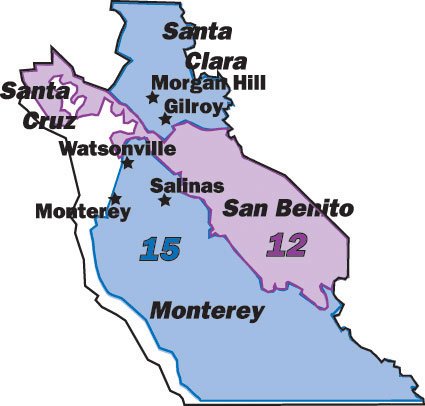GILROY
– Forget Halloween pumpkins – the most impressive carving-up job
in South County this fall may be in the political arena.
GILROY – Forget Halloween pumpkins – the most impressive carving-up job in South County this fall may be in the political arena.
When South County residents open their voter guides and then take to the polls for Tuesday’s elections, they’ll bear direct witness to the results of a political redistricting process that may seem like the handiwork of slasher film star Freddy Krueger.
Not only were South County’s individual communities split apart from their brethren in last year’s redistricting, but some – such as Morgan Hill – found themselves lumped in with new towns and voters that locals considered way too distant, both geographically and politically.
The net result: the disdain of many local officials – including Democrats and Republicans alike – although sometimes for slightly different reasons.
“We have a lot of common things and goals to work on,” Gilroy City Councilman Charlie Morales said of South County’s communities. “When they lump us with other districts, we don’t have the commonality, the common goals (on) housing, the demographics.”
Before last year, Gilroy, San Martin and Morgan Hill – all major bedroom communities for Silicon Valley and its tech jobs up north – generally resided together in the higher political realms of government: the U.S. Congress, state Senate and state Assembly.
Then came redistricting, the process after every census where the state Legislature redraws political boundaries, theoretically to smooth out shifts in population.
By the time Gov. Gray Davis signed off on the process last fall, the South County communities were in three disparate Congressional districts and two separate Assembly jurisdictions – separated from each other and long-established political relationships by scraggly lines on district maps that sometimes resemble political earthquake faults.
Take Morgan Hill. Instead of remaining in the traditional 16th Congressional District with tech-savvy San Jose – where upwards of two-thirds of their workers travel to their jobs – the “mushroom capital” found itself in the largely agricultural 11th District.
That jurisdiction bypasses San Jose almost entirely, but includes large swaths of the more conservative Central Valley and its communities such as Manteca and Lodi (of Creedence Clearwater Revival fame), as well as fairly distant East Bay cities such as San Ramon and Dublin.
The move meant replacement of longtime Democratic Rep. Zoe Lofgren with Republican Richard Pombo, a Tracy rancher who also served his prior district for several terms. Pombo is facing off this November against Elaine Shaw, a Democratic business lawyer from Danville.
Meanwhile, Gilroy finds itself in the 15th Congressional District, which includes roughly a third of San Jose as well as suburbs such as Campbell, Cupertino and Los Gatos.
Democratic incumbent Rep. Mike Honda – who represented South County several years ago as District 1 County Supervisor – is facing off there against Republican challenger Linda Rae Hermann, a trustee in East San Jose’s Berryessa Union School District.
Only unincorporated San Martin – the tiny hamlet between the two South County cities – remained in Lofgren’s 16th District, which includes the other two-thirds of San Jose.
The movement prompted upset Morgan Hill officials to file a lawsuit against the state – still pending – arguing the new maps put them into a district that shares few common interests.
“I can’t see, when we are so remote in the district and the values and whole agrarian nature of 95 percent of the district, where you’d find the time to get down here or (take) interest in our issues …” said Morgan Hill Councilman Steve Tate. “It’s a matter of scale, with Congressional districts so large and us being a tiny pimple on the end.”
Morgan Hill and Gilroy were separated again in redistricting for the state Assembly.
Both cities were traditionally part of the sprawling 28th Assembly District, which now stretches south to King City and includes Salinas, Hollister and major inland portions of Monterey and Santa Cruz counties. Republican Jane Howard faces what could be an uphill battle against incumbent Democrat Simon Salinas in that race.
However, the redistricting bumped Morgan Hill into a new district, the 27th, which stretches from Morgan Hill west to Saratoga and then south along the coast through Santa Cruz and western Monterey County.
Democrat John Laird is facing off against Republican Chuck Carter to represent that district, vacated by longtime Santa Cruz Democrat Fred Keeley because of term limits.
So how did it all happen?
Legislators were focused on politics – not necessarily local geography, said Terry Christensen, a San Jose State University political science professor.
Christensen said both Republicans and Democrats in the Legislature made a deal to draw districts that maximized partisan majorities for one or the other through the redistricting process. That guaranteed incumbents reelection and the future control of various districts by the party with the majority.
“They weren’t really looking at the contiguity of communities, they were looking at the partisan ballots,” he said. “It’s in their legal right to do that, but the federal law and court cases also say you’re supposed to respect communities.”
Local governments can indeed argue that the redistricting process did disrespect to their communities, but it’s a fine line, Christensen said – and for Morgan Hill, probably a tough row to hoe.
Morgan Hill will have to show it, as a city and a group of voters, is more like the rest of Santa Clara County than their new district, Christensen said, and that they really do have a strong commonality of interest.
“I think they could do it, but I don’t know that this is such an extreme example of redistricting that the court will react to it,” he said.
Historically, courts have been most concerned about equalizing population, he said, followed by minority voting and representation – whether an ethnic group will lose power through the redistricting.
“If Morgan Hill was a majority Latino or Asian, I think they’d have a better shot,” he said. “If they’d done it to Gilroy, Gilroy would have a better shot getting out than Morgan Hill does.”
To Gilroy Councilman Morales, breaking up South County on the overall political maps doesn’t make sense because it splits up an area with a lot of common ground. He cites safety improvements along U.S. 101 in South County as an example.
“That was a result of common goals shared by the cities,” he said. “That’s how we made it happen.”
While being tied to a larger community can help draw funding that could help with mutual concerns, Morales doubts that offsets the effects of the splits.
Fragmenting South County may indeed complicate regional political efforts – or it could lead to a new or higher level of representation, Christensen said.
For example, instead of one member of Congress, the area may find three pulling for it, he said. And having Pombo – a Republican – as a new member of the local delegation could prove be useful with the current GOP majority in the House of Representatives.
“It can be helpful, or it could mean that no one pays attention to you,” Christensen said of the fragmentation. “You could have three representatives, or you could have zero because they think it’s too small a part of the district to be bothered with.”
Don Gage, who represents all three South County communities on the Santa Clara County Board of Supervisors, notes the switches mean he may now have to deal with more people when working with higher government for his district – but it means there are now more people working for the area.
“As far as working with them, it’s not going to have any impact,” said the Republican supervisor. “You just change the players you have to work with, and some may be a little farther away.”
Gage thinks the real problem with the redistricting was the gerrymandering.
“They did the redistricting to secure their elected positions and ensure the Democratic Party would be the dominant party,” he said.
Christensen noted that nearly everyone in the Legislature – Democrats and Republicans alike – went along with the redistricting plan, although that’s not necessarily the fault of South County GOP backers.
“I, personally, think the Republican Party sold out their voters in doing this, because they’ve guaranteed Republican minorities in the (state) Legislature for a decade,” he said.














